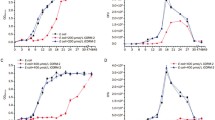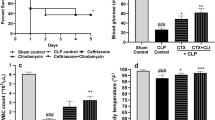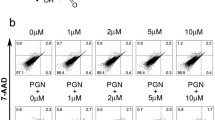Abstract
Objective and design
To investigate the therapeutic effect of E5564 (a clinically used TLR4 inhibitor) in murine abdominal sepsis elicited by intraperitoneal infection with a highly virulent Escherichia coli in the context of concurrent antibiotic therapy.
Methods
Mice were infected with different doses (~2 × 104–2 × 106 CFU) of E. coli O18:K1 and treated after 8 h with ceftriaxone 20 mg/kg i.p. combined with either E5564 10 mg/kg i.v. or vehicle. For survival studies this treatment was repeated every 12 h. Bacterial loads and inflammatory parameters were determined after 20 h in peritoneal lavage fluid, blood, liver and lung tissue. Plasma creatinin, AST, ALT and LDH were determined to assess organ injury.
Results
E5564 impaired bacterial clearance under the antibiotic regime after infection with a low dose E. coli (1.7 × 104 CFU) while renal function was slightly preserved. No differences were observed in bacterial load and organ damage after infection with a tenfold higher (1.7 × 105 E. coli) bacterial dose. While treatment with E5564 slightly attenuated inflammatory markers provoked by the sublethal doses of 104–105 E. coli under the antibiotic regime, it did not affect lethality evoked by infection with 1.7 × 106 E. coli.
Conclusions
The impact of TLR4 inhibition during abdominal sepsis by virulent E. coli bacteria is only beneficial at low infection grade at cost of bactericidal activity.



Similar content being viewed by others
References
van der Poll T. Opal SM: host-pathogen interactions in sepsis. Lancet Infect Dis. 2008;8:32–43.
Ranieri VM, Thompson BT, Barie PS, Dhainaut JF, Douglas IS, Finfer S, et al. Drotrecogin alfa (activated) in adults with septic shock. N Engl J Med. 2012;366:2055–64.
Rittirsch D, Flierl MA, Ward PA. Harmful molecular mechanisms in sepsis. Nat Rev Immunol. 2008;8:776–87.
Barochia AV, Cui X, Natanson C, Eichacker PQ. Risk of death and the efficacy of eritoran tetrasodium (E5564): design considerations for clinical trials of anti-inflammatory agents in sepsis. Crit Care Med. 2010;38:306–8.
Angus DC. The search for effective therapy for sepsis: back to the drawing board? JAMA. 2011;306:2614–5.
Renckens R, Roelofs JJ, Florquin S, van der Poll T. Urokinase-type plasminogen activator receptor plays a role in neutrophil migration during lipopolysaccharide-induced peritoneal inflammation but not during Escherichia coli-induced peritonitis. J Infect Dis. 2006;193:522–30.
Renckens R, Roelofs JJ, Florquin S, de Vos AF, Pater JM, Lijnen HR, et al. Endogenous tissue-type plasminogen activator is protective during Escherichia coli-induced abdominal sepsis in mice. J Immunol. 2006;177:1189–96.
Schouten M, Van’t Veer C, Levi M, Esmon CT, van der Poll T. Endogenous protein C inhibits activation of coagulation and transiently lowers bacterial outgrowth in murine Escherichia coli peritonitis. J Thromb Haemost. 2011;9:1072–5.
van’t Veer C, van den Pangaart PS, Kruijswijk D, Florquin S, de Vos Alex F, van der Poll T. Delineation of the role of Toll-like receptor signaling during peritonitis by a gradually growing pathogenic Escherichia coli. J Biol Chem. 2011;286:36603–18.
Turnbull IR, Wlzorek JJ, Osborne D, Hotchkiss RS, Coopersmith CM, Buchman TG. Effects of age on mortality and antibiotic efficacy in cecal ligation and puncture. Shock. 2003;19:310–3.
Rijneveld AW, Florquin S, Hartung T, Speelman P, van der PT. Anti-tumor necrosis factor antibody impairs the therapeutic effect of ceftriaxone in murine pneumococcal pneumonia. J Infect Dis. 2003;188:282–5.
Wang E, Bergeron Y, Bergeron MG. Ceftriaxone pharmacokinetics in interleukin-10-treated murine pneumococcal pneumonia. J Antimicrob Chemother. 2005;55:721–6.
Gladwin M. Clinical Microbiology Made Ridiculously Simple. 4th ed. Miami: Med Master, Inc.; 2007.
Cross A, Asher L, Seguin M, Yuan L, Kelly N, Hammack C, et al. The importance of a lipopolysaccharide-initiated, cytokine-mediated host defense mechanism in mice against extraintestinally invasive Escherichia coli. J Clin Invest. 1995;96:676–86.
Webster NR, Galley HF. Immunomodulation in the critically ill. Br J Anaesth. 2009;103:70–81.
Branger J, Knapp S, Weijer S, Leemans JC, Pater JM, Speelman P, et al. Role of Toll-like receptor 4 in gram-positive and gram-negative pneumonia in mice. Infect Immun. 2004;72:788–94.
Wieland CW, van Lieshout MH, Hoogendijk AJ, Van Der Poll T. Host defence during Klebsiella pneumonia relies on haematopoietic-expressed Toll-like receptors 4 and 2. Eur Respir J. 2011;37:848–57.
Daubeuf B, Mathison J, Spiller S, Hugues S, Herren S, Ferlin W, et al. TLR4/MD-2 monoclonal antibody therapy affords protection in experimental models of septic shock. J Immunol. 2007;179:6107–14.
Roger T, Froidevaux C, Le RD, Reymond MK, Chanson AL, Mauri D, et al. Protection from lethal gram-negative bacterial sepsis by targeting Toll-like receptor 4. Proc Natl Acad Sci USA. 2009;106:2348–52.
Spiller S, Elson G, Ferstl R, Dreher S, Mueller T, Freudenberg M, et al. TLR4-induced IFN-gamma production increases TLR2 sensitivity and drives Gram-negative sepsis in mice. J Exp Med. 2008;205:1747–54.
Solomon SB, Cui X, Gerstenberger E, Danner RL, Fitz Y, Banks SM, et al. Effective dosing of lipid A analogue E5564 in rats depends on the timing of treatment and the route of Escherichia coli infection. J Infect Dis. 2006;193:634–44.
Visintin A, Halmen KA, Latz E, Monks BG, Golenbock DT. Pharmacological inhibition of endotoxin responses is achieved by targeting the TLR4 coreceptor, MD-2. J Immunol. 2005;175:6465–72.
Wasan KM, Sivak O, Cote RA, MacInnes AI, Boulanger KD, Lynn M, et al. Association of the endotoxin antagonist E5564 with high-density lipoproteins in vitro: dependence on low-density and triglyceride-rich lipoprotein concentrations. Antimicrob Agents Chemother. 2003;47:2796–803.
Deng T, Feng X, Liu P, Yan K, Chen Y, Han D. Toll-like receptor 3 activation differentially regulates phagocytosis of bacteria and apoptotic neutrophils by mouse peritoneal macrophages. Immunol Cell Biol. 2012;91(1):52–9.
Jain V, Halle A, Halmen KA, Lien E, Charrel-Dennis M, Ram S, et al. Phagocytosis and intracellular killing of MD-2 opsonized gram-negative bacteria depend on TLR4 signaling. Blood. 2008;111:4637–45.
Castoldi A, Braga TT, Correa-Costa M, Aguiar CF, Bassi EJ, Correa-Silva R, et al. TLR2, TLR4 and the MYD88 signaling pathway are crucial for neutrophil migration in acute kidney injury induced by sepsis. PLoS One. 2012;7:e37584.
Watts BA III, George T, Sherwood ER, Good DW. A two-hit mechanism for sepsis-induced impairment of renal tubule function. Am J Physiol Renal Physiol. 2013;304(7):F863–74.
Liu M, Gu M, Xu D, Lv Q, Zhang W, Wu Y. Protective effects of Toll-like receptor 4 inhibitor eritoran on renal ischemia-reperfusion injury. Transplant Proc. 2010;42:1539–44.
Chun KH, Seong SY. CD14 but not MD2 transmit signals from DAMP. Int Immunopharmacol. 2010;10:98–106.
Martin C, Ragni J, Lokiec F, Guillen JC, Auge A, Pecking M, et al. Pharmacokinetics and tissue penetration of a single dose of ceftriaxone (1,000 milligrams intravenously) for antibiotic prophylaxis in thoracic surgery. Antimicrob Agents Chemother. 1992;36:2804–7.
Martin C, Cottin A, Francois-Godfroy N, Mallet MN, Martin A, Sastre B, et al. Concentrations of prophylactic ceftriaxone in abdominal tissues during pancreatic surgery. J Antimicrob Chemother. 1997;40:445–8.
Elson G, Dunn-Siegrist I, Daubeuf B, Pugin J. Contribution of Toll-like receptors to the innate immune response to Gram-negative and Gram-positive bacteria. Blood. 2007;109:1574–83.
Liang MD, Bagchi A, Warren HS, Tehan MM, Trigilio JA, Beasley-Topliffe LK, et al. Bacterial peptidoglycan-associated lipoprotein: a naturally occurring toll-like receptor 2 agonist that is shed into serum and has synergy with lipopolysaccharide. J Infect Dis. 2005;191:939–48.
Acknowledgments
We acknowledge Eisai Inc., Woodcliff Lake, NJ for the supply of E5564 and Joost Daalhuisen and Marieke ten Brink for expert technical assistance. This work was supported by the AMC Graduate School of Medical Science (to M. H. P. v. L.).
Author information
Authors and Affiliations
Corresponding author
Additional information
Responsible Editor: Artur Bauhofer.
Rights and permissions
About this article
Cite this article
van Lieshout, M.H.P., van der Poll, T. & van’t Veer, C. TLR4 inhibition impairs bacterial clearance in a therapeutic setting in murine abdominal sepsis. Inflamm. Res. 63, 927–933 (2014). https://doi.org/10.1007/s00011-014-0766-9
Received:
Revised:
Accepted:
Published:
Issue Date:
DOI: https://doi.org/10.1007/s00011-014-0766-9




